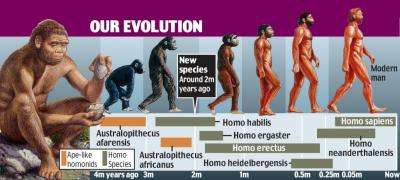April 6, 2010 report
New species of early hominid found

(PhysOrg.com) -- A previously unknown species of hominid that lived in what is now South Africa around two million years ago has been found in the form of a fossilized skeleton of a child and several bones of adults. The new species may be a transitional stage between ape-like hominids and Homo habilis, the first recognizably human ancestor of Homo sapiens.
The skeleton and bones were discovered in the Sterkfontein area near Johannesburg by researchers from the University of the Witwatersrand. The team, led by Professor Lee Berger, were exploring the Malapa cave systems, in which an almost complete fossilized Australopithecus skeleton was discovered in 1994. The limestone caves are now a UNESCO world heritage site and an area that has been extensively excavated to unearth its paleontological treasures.
Professor Phillip Tobias from the University of the Witwatersrand said the findings were exciting because it is rare to find a skeleton; a few bones or teeth are more commonly discovered. Professor Tobias was involved in the identification of Homo habilis as a new human species in 1964, and said the specimens found by Professor Berger and colleagues were “wonderful”.
Full details of the as-yet unnamed discovery have not been released, but since the finds include fossils of an almost complete skeleton they should be able to reveal information on the gait and posture of the species, and the dexterity of their hands. The scientists should also be able to infer from the structure of the feet whether or not the species was primarily arboreal. The dating of the fossils places them in the period in which complex stone tool use and language were emerging, and when hominids were abandoning the trees permanently.
Africa is widely accepted as the “Cradle of Mankind,” where simple primates evolved into the common ancestor of humans and great apes. The common ancestor gave way to two branches that diverged about six million years ago, with one evolving into species such as chimpanzees and gorillas, and the other evolving into the upright-walking Australopithecus afarenus, an ape-like species that emerged around 3.9 million years ago, and the later Homo habilis, which emerged about 2.5 million years ago, and which used complex stone tools and had several human-like traits, including a much larger brain.
The fossils of the new species have been kept out of public view, but have been viewed by South Africa’s President Jacob Zuma. Very few scientists have so far seen the finds, but they will be officially unveiled on Thursday.
© 2010 PhysOrg.com


















